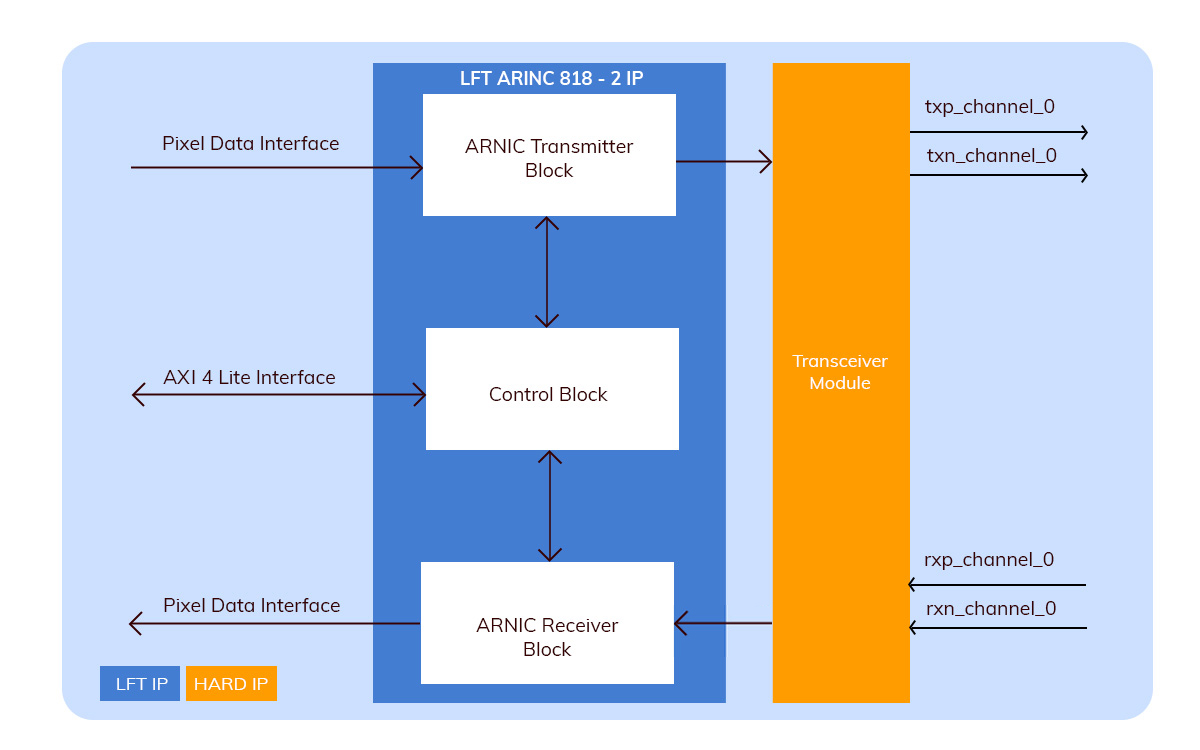ARINC 818 Standard – Key Features: Mission-critical applications including sensor systems, mission recorders, and cockpit displays require smooth, high-bandwidth, low-latency video transmission, according to the aerospace manufacturing sector.
As a dependable and expandable solution for high-performance video and data transport, the ARINC 818 Avionics Digital Video Bus (ADVB) standard was created to meet these demands.
ARINC 818 was created especially for the aerospace and defense industries.
It allows for the deterministic, real-time transmission of uncompressed or lightly compressed video while guaranteeing precision, security, and compatibility with a variety of cutting-edge avionics platforms.
The high-speed, low-latency features of the ARINC 818 video interface standard have made it more and more popular in the aviation sector.
A complete solution that offers hardware acceleration for this video interface standard is the ARINC 818 IP Core.
We will discuss the main characteristics that make ARINC 818 a supported standard in this blog, as well as its uses in mission-critical aerospace programs across the globe.
ARINC 818
ARINC 818: A video interface and protocol standard called Avionics Digital Video Bus (ADVB) was created for avionics systems that require high bandwidth, low latency, and uncompressed digital video transmission.
Since its January 2007 introduction, ARINC and the aerospace community have worked to enhance the standard to satisfy the demanding requirements of high-performance digital video.
Following an upgrade to the specification, ARINC 818-2 was published in December 2013 with several new capabilities, such as bi-directional control, channel-bonding, switching, field sequential color, link rates up to 32X fiber channel rates, and data-only links.
In 2018, ARINC 818-3 was made available. This update addressed a number of bugs and highlighted the differences between the 8b/10b and 64b/66b encoding rates.
ARINC 818 Protocol
A point-to-point serial protocol for data, audio, and video transmission, ARINC 818 (Avionics Digital Video Bus) is 8b/10b encoded (or 64B/66B for faster speeds).
While packetized, the protocol is video-centric and highly adaptable, enabling a variety of intricate visual tasks such as transmitting a single stream over a dual connection or multiplexing multiple video streams over a single link.
ARINC 818 – 2 – In order to handle faster link rates, networking, encryption and compression, and advanced display systems including channel bonding for large area displays (LADs), ARINC 818-2 was ratified in December 2013.
ARINC 818 – 3 – For dependable high-speed video transmission, ARINC 818-3 adds established latency budgets, enhanced encoding, and larger data rates.
High-bandwidth sensors, VR cockpits, and 4K/8K displays are just a few of the next-generation aerospace applications that it powers.
Core Features of a Typical ARINC 818 IP Solution

Bandwidth
Early link speeds ranged from 1.0625 to 8.5 Gbps; with ARINC 818-2, they were eventually increased to 28.05 Gbps with ARINC 818-3, providing flexibility by accommodating coax and non-standard return channel rates.
Switching:
ARINC 818, which was initially point-to-point, is increasingly using switching for multi-display systems while maintaining stringent compatibility standards.
Compression & Encryption:
When necessary, it supports compressed and encrypted payloads (data, video, and audio), with implementation specified in the Interface Control Document (ICD).
Channel Bonding:
To get over FPGA bandwidth restrictions, it is possible to divide video across several channels.
Data-only Links:
ARINC 818-2 compliant, used for command-and-control (e.g., camera operations), with standard or customized connection rates specified in ICD.
CRC Calculation:
ARINC 818-2 provided thorough examples to help clarify CRC computation and prevent errors in image integrity checks.
Typical Use Cases and Applications
- Cockpit Display Systems: Transmits high-resolution video to pilot and crew displays for critical flight information.
- Mission Computing & Sensor Fusion Platforms: Integrates and processes multiple sensor streams in real-time for situational awareness.
- Ground Control Stations & Simulators: Provides reliable video and data links for monitoring, training, and system control.
- Unmanned Aerial Vehicles (UAVs) & ISR Platforms: Enables high-bandwidth communication for surveillance, reconnaissance, and remote operations.
ARINC 818 Solutions Portfolio by Logic Fruit Technologies
ARINC 818-2 IP Core
A reliable and powerful ARINC 818-2 Transmitter & Receiver IP Core has been created by Logic Fruit Technologies specifically for avionics applications requiring high-resolution, real-time video transmission.
This IP core offers scalable performance for a variety of cockpit display systems and fully supports ARINC 818-2, the improved version of the ARINC 818 standard. It can operate at various line rates up to 8.5 Gbps.

Features of ARINC 818-2 IP Core – Logic Fruit Technologies
- ARINC 818-2 Compliant: Fully aligned with the latest ADVB standard for interoperability.
- High-Speed Transmission: Supports data rates up to 8.5 Gbps for real-time, high-resolution video.
- FC-AV Protocol: Built on a proven Fibre Channel Audio Video framework.
- 8B/10B Encoding: Reliable serial transmission with strong error detection.
- Flexible Interfaces: Supports both optical and electrical links.
- Precise Timing: Line-segmentation and synchronous transmission for accurate video handling.
- Error Monitoring: Receiver reporting with user data support for diagnostics.
- Certified Design: CEMILAC approved and DO-254 DAL-B compliant for aerospace safety.
To know more features and specifications about ARINC 818 – 2 IP Core
ARINC 818-3 IP Core
In order to satisfy the sophisticated data and video transmission requirements of next-generation avionics systems, Logic Fruit Technologies has created a high-speed ARINC 818-3 Transmitter and Receiver IP Core that supports line rates of up to 28 Gbps.
High reliability and adherence to strict aerospace requirements are guaranteed by this IP core, which was designed using the DO-254 process and verified by CEMILAC.
It provides reliable, point-to-point serial communication and is perfect for incorporation into mission processors, high-resolution cockpit displays, and other crucial airborne video interfaces.
It is based on the Fibre Channel Audio Video (FC-AV) protocol.

Features and benefits of ARINC 818-3 IP Core
- Compliance: Meets ARINC 818-3 standards for seamless avionics integration.
- Speed: Supports up to 28 Gbps for ultra-high-bandwidth video/data.
- Foundation: Based on robust Fibre Channel Audio Video (FC-AV) protocol.
- Efficiency: Uses 64B/66B and 256B/257B encoding for higher throughput.
- Flexibility: Works with both optical and electrical links.
- Synchronization: Enables precise frame handling with line-segmentation.
- Diagnostics: Offers error detection, reporting, and user data support.
- Certification: DO-254 compliant and CEMILAC certified for safety-critical use.
To know more about the features and benefits of ARINC 818-3 IP Core
ARINC 818 Monitor
The ARINC 818 Monitor is a small, stand-alone device that uses a 15-inch LCD panel to accept and show ARINC 818 video inputs.
It supports many video resolutions by performing real-time digitizing, scaling, and frame rate conversion thanks to its high-speed signal processing capabilities.
The monitor provides a dependable and effective way to precisely and clearly visualize ARINC 818-compliant video streams, making it perfect for testing, validation, and monitoring in avionics situations.
ARINC 818 Video Protocol ANALYZER
The ARINC 818 Video Protocol Analyzer is a small, FPGA-based device that effectively analyzes ARINC 818-2 protocol data by capturing, decoding, and displaying ADVB packets.
It facilitates faster debugging and validation of video streams in aerospace and aviation systems by supporting DVI / Test patterns to ARINC 818 conversion and ARINC 818 to DVI conversion, which makes it a vital tool for test and development environments.
ARINC 818 Video Analyzer & Multiformat Video Generator (AVAG)
For developing and validating ARINC 818-2 video protocols, the ARINC 818 Video Analyzer & Multiformat Video Generator (AVAG) provides a flexible solution.
With support for up to 4x (1.0625/2.125/4.25 Gbps) data speeds, it allows for the analysis of FC-packets and the transmission of analog video in STANG format as well as digital video in ARINC 818.
The system can manage both traditional and high-speed video systems because of its adjustable resolutions and compatibility for DVI-D and HDMI standards.
ARINC 818 Video Protocol Converters
ARINC 818 to DVI Video Converters
In order to enable smooth presentation on flat panels, the ARINC 818 to DVI Video Converter effectively transforms ARINC 818 input signals into digital DVI output.
Its interoperability with a variety of display systems is ensured by its standard digitization and frame rate conversion.
DVI to ARINC 818 Video Converter
High-speed signal digitization and frame rate conversion for digital flat panel displays are made possible by the DVI to ARINC 818 Video Converter, a stand-alone device that transforms DVI input signals to ARINC 818 output.
With its compatibility for several resolutions, digital display systems may be seamlessly integrated.
Conclusion
The ARINC 818 standard, which offers a versatile, fast, and dependable framework for sending vital data and video, has grown to become a mainstay of contemporary avionics.
It is a reliable option for both commercial and defense aerospace applications due to its scalability from cockpit displays to mission computing, ground systems, and UAV platforms.
The standard is well-positioned to accommodate next-generation requirements like 4K/8K screens and windowless cockpits.
It also supports virtual reality systems and sophisticated sensor fusion. These advancements are possible due to ongoing improvements in bandwidth, encoding, and interoperability.
Updates like ARINC 818-2 and ARINC 818-3 have further strengthened its capabilities.
ARINC 818 will continue to play a crucial role in facilitating smooth integration, real-time video distribution, and long-term system scalability as aerospace systems advance toward increased performance and complexity.
Adhering to ARINC 818 guarantees both current and future readiness for businesses looking for trustworthy solutions in this field.











